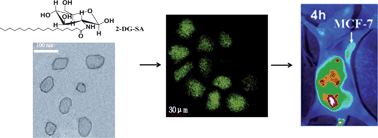Glucosamine derivative modified nanostructured lipid carriers for targeted tumor delivery
Abstract
Stearyl-2-amino-2-deoxyglucose (2-DG) modified nanostructured

* Corresponding authors
a
Department of Biomedical Engineering, School of Life Science and Technology, State Key Laboratory of Natural Medicines, China Pharmaceutical University, 24 Tongjia Lane, Gulou District, Nanjing, China
E-mail:
guyueqing@cpu.edu.cn
b Department of Radiology, School of Medicine, Washington University, St. Louis, Missouri, USA
Stearyl-2-amino-2-deoxyglucose (2-DG) modified nanostructured

 Please wait while we load your content...
Something went wrong. Try again?
Please wait while we load your content...
Something went wrong. Try again?
J. Chen, H. Chen, S. Cui, B. Xue, J. Tian, S. Achilefu and Y. Gu, J. Mater. Chem., 2012, 22, 5770 DOI: 10.1039/C2JM15830B
To request permission to reproduce material from this article, please go to the Copyright Clearance Center request page.
If you are an author contributing to an RSC publication, you do not need to request permission provided correct acknowledgement is given.
If you are the author of this article, you do not need to request permission to reproduce figures and diagrams provided correct acknowledgement is given. If you want to reproduce the whole article in a third-party publication (excluding your thesis/dissertation for which permission is not required) please go to the Copyright Clearance Center request page.
Read more about how to correctly acknowledge RSC content.
 Fetching data from CrossRef.
Fetching data from CrossRef.
This may take some time to load.
Loading related content
